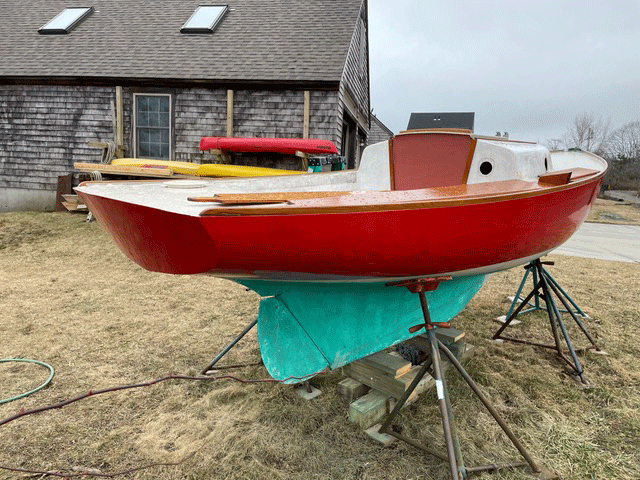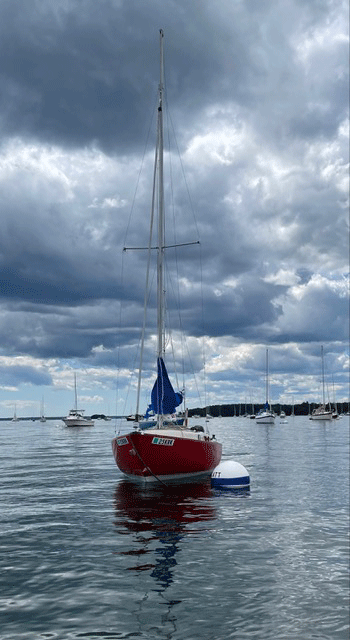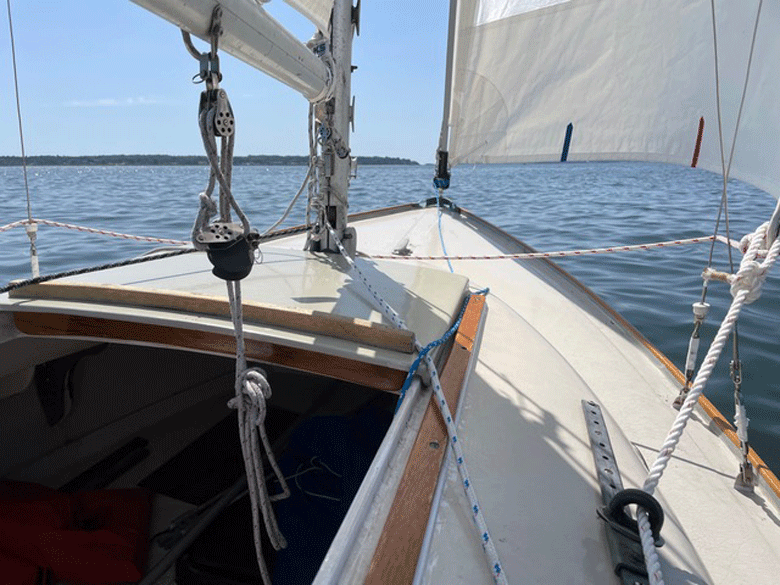I’ve been a boat owner for well over 50 years. So I should know something about the rocks and shoals that lie in wait for someone like me, right? The costs? The heartbreak? The disasters that lurk out there on, in or under the water?
I thought I did—all of us boat owners think we know—until we forget. Over the years I’ve forgotten lots of times. Last summer my memory failed me, yet again: at the age of 80, I bought another boat.
I’d been boatless, more or less, at least in a serious way, for several years. I’d satisfied my cravings with a rowboat attached to a running line in front of our house that took me out into Casco Bay when things were calm and the tide was right. Rowing that boat’s fun and keeps me in better shape than some old guys, but when I’m out there I get to thinking… wouldn’t it be fun to go for a sail? In a sailboat? Just a little one, safe, manageable, not too much trouble?
You know what happened next. Blame it on the internet. I began (back on shore, not out in the rowboat) surfing boat listings here and there, narrowing them down to boats under 20 feet, older, fiberglass (I’ve owned and written about wooden boats, taken care of them, and knew I wanted to sail, not caulk and paint, in the years I’ve got left). I was willing to take on a project as long as it could get me back out there.
Finally, after months of surfing and imagining, I found something really interesting and unusual. Practical? Sensible? Safe? Something a guy my age should undertake? I leave the answers to those questions up to you.
All I had to do was drive to Connecticut to see the boat for myself, decide whether to buy it, somehow get it to Maine without a trailer, cover it for the winter, and then in spring put it back together, fix what might need fixing, launch it, rig it, get from a launch site to the mooring I still owned, and go sailing.
Evidence of insanity? Let’s be honest here: of course!
I’d had a Cape Dory 30—a bigger version of this boat—for a couple of seasons a few years back, and I remember loving its sailing qualities.
The early fall drive down to Connecticut in my pickup was easy. I went alone—no wife, no dog, just a checkbook—and pulled into a small cluster of buildings where I parked and went into what looked like an office. I explained my mission to a pleasant woman (I was expected) who told me I’d need to speak with her husband.
I did, and he took me out to show me the boat I was looking for in a plastic-covered shed. I prowled around and went aboard, poked and prodded while he told me the boat’s interesting story.
Built in 1971, this Cape Dory Typhoon was one of several hundred produced by a successful firm in Massachusetts working from designs by Carl Alberg. Alberg’s hulls are traditional, with full keels and reasonable overhangs, generally good sailers that can handle most sea conditions without scaring people.
I’d had a Cape Dory 30—a bigger version of this boat—for a couple of seasons a few years back, and I remember loving its sailing qualities. Memories of that boat, in fact, had gotten me thinking about Cape Dory for my old-age boat.
I’d looked at a number of Typhoons in Maine in the preceding months, mostly on the internet and a couple in person, but hadn’t found anything that wouldn’t overwhelm me with rebuilding work.
It’s amazing to me how people let boats go. If they’re wooden boats, they rot and fall apart; if they’re fiberglass they get tired and shabby, slowly turning into junk cars or old refrigerators out in people’s yards. Not enticing!
The boat in Connecticut was different. An earlier owner had turned it over to the man I was talking to last summer in his plastic shed so it could be refurbished from end to end. He’d begun the work by removing all the fittings, coamings, hatch, and anything else that could be unscrewed, stashing it all in boxes and bags in the shed.
Once he’d cleared the decks, so to speak, he went to work on the hull, sanding and then painting it a shiny bright red. This part of his job was—and remains—absolutely beautiful, and I can only wish he’d been able to finish the rest of his project.
But as is often the case with boats, a black swan—an unforeseen event—intervened. The client died. There sat the boat, now bright red, in the shed. Unfinished. In the way.
Time must have gone by, I’m not sure how much of it. Suffice it to say that the man I was dealing with had been left with a project just begun without a clear end in sight. His solution (presumably agreed to by the client’s heirs because he owned the boat by the time I looked at it) was to put the hull, its fittings, and associated parts, mast, boom and sails—on the market. The price was $1,500, way below any other Typhoon I’d looked at. I knew most of this story before driving down, and—even knowing that “B-O-A-T” really stands for “bring out another thousand,” I skipped the dickering and agreed to his price.
That evening I arrived home with a truckload of boat parts and a new project in prospect: figuring out to get my new red hull from Connecticut to Maine.
Janice, my wife, is an understanding person. She let me finish what I started to say when I drove in with my truckload—that this boat didn’t mean I planned to leave her and sail away. It was a project I could do over the winter, the sort of thing I’ve loved to do since I retired a few years back. (In my years since then I’ve overseen the construction of a summer cottage, built a couple of small boats, crafted lots of furniture and turned a one-time Odd Fellows hall into a home for myself. Why not another project?)
Janice demonstrated her tolerance and understanding as I appropriated part of our home’s lawn for the hull, some of the garage for the spars, and a piece of the cellar for the rest of the nautical junk I’d bought at such a bargain price.
Next, after considerable investigating, I arranged for a transporter to truck my red hull to Maine (“B-O-A-T” again but had to be); once the boat got here, I painted the decks so they’d be ready when spring came. I bought a heavy tarp and tied it down so the boat wouldn’t fill up with ice and snow after its protected time in the Connecticut shed. I hung up the mast in the garage and went through the nautical junk to see what I might accomplish over the winter.
Twice, at least, I was obliged to pump out a foot of water in the bilge that had come in through the deck holes.
Janice, perhaps relieved that I wouldn’t sail away too soon, listened to my babblings about this project and went on with normal life.
The weather got colder. I headed for my shop in the cellar where I laid out coamings and other mahogany trim and began sanding and refinishing. I re-created missing parts here and there and finished them.
Winter came and went. From time to time I’d check on things under the boat cover, at least once chipping and digging out ice that accumulated in the bilge—cold work, no damage, promises to myself that I’d build a better cover frame next year.
All evidence of insanity, of course. But I was having fun down in my shop, refinishing and refreshing various nautical tchotchkes while dreaming of spring work inside the boat and more painting and finishing on the outside—plus, of course, sailing! All at my advanced age!

I was finishing up my shop work when spring finally came. Conditions outdoors improved. Between rains I began untying my tarp and exploring the hull out in the yard, figuring out what kind of projects I could expect next.
The first, I could see, was stiffening the set of plywood knees beneath the through-deck chainplates—the old knees had been soaked by deck leaks and were delaminating. Crawling into the cramped cabin space I made cardboard patterns of the originals. In my shop I cut out a new set of knees.
Making and installing the knees was the first indication that I was in for some below-decks experiences that would be different from those aboard my earlier boats—not just because this boat is smaller and more cramped, but because I don’t bend or move around as well as I once did.
More than a few minutes down there would leave me stiff and sore, sometimes requiring various cures: muscle-relaxing drugs, stiff drinks, simply time to stretch out.
But I got this job done and moved on, fixing and re-installing the hatch and its accompanying cockpit slides; putting portholes back in place, fitting the refinished cockpit coamings into their places, starting on deck fittings, most of which required more below-decks crawling, slithering, and soreness in order to tighten down the washers and nuts.
By June or thereabouts I was getting there—running out of fittings to put on, bottom and boot top painted, cabin space vacuumed out, mast and rigging moved from the garage onto sawhorses outside and checked over. I bought a supply of cotter pins and clevis pins to use when we stepped the mast. I began hatching a launching plan.
Rain was more-or-less continuous in June, keeping the decks washed but causing an unexpected problem: leaks through a bunch of quarter-inch holes in the deck, places for fittings I either didn’t have or had elected to install later.
Twice, at least, I was obliged to pump out a foot of water in the bilge that had come in through the deck holes. Fortunately I’d bought a wonderful hand pump with a hose I could hang over the side, meaning I was in for fewer sponge-and-bucket jobs. Still, the rain made me keep all appropriate bilge and cockpit draining tools at hand, and at least it told me the boat wasn’t going to leak—the bilge was keeping water inside very well, I reasoned, so it shouldn’t come in through the bottom. As for those quarter-inch deck holes, I covered them with duct tape.
The tape didn’t look great, but at least the bilge stopped filling up.
Somewhere around this time I got a message from the co-owner of the mooring I planned to use, reporting that he’d heard from the harbormaster that the mooring’s ball had gone adrift and the chain to the bottom. Time for a fix, so I called the guys who’d serviced it this season. They went and looked, dove down, found the chain on the bottom, and re-attached it to a new ball.

All fixed (at my expense – B-O-A-T.) so we were good to go. Of course it was still raining so there was no need to worry about launching yet.
I gave a lot of thought to launching, however. This was a new boat to me, and it hadn’t been in the water for some years, so I didn’t want to find myself setting up a 24-foot aluminum mast with a friend or two (I’d done that before) and tightening down the turnbuckles alongside some float while we held things in place. No—better to book a session at a boatyard where a rigging crew does the job.
I settled on a yard downtown where I could stay dockside for a day or so while I sorted out lines, bags of sails, and other stuff that had come with the boat and had sat in my garage over the winter. This plan required an outboard motor I could put on the stern bracket that would get me to the mooring, three miles away in Falmouth.
The launch went well. The yard crew installed the mast and stays. I spent a day at a float getting everything shipshape. The outboard motor, an old Seagull I’d owned for years, proved balky so I had it serviced before I hung it on the bracket and started it up. All fine, until….
With a friend I’d recruited I boarded early the next morning. The outboard started in its usual plume of smoke. We cast off, and about ten feet off the dock the motor stopped and wouldn’t start again. We drifted back to the dock, tied up and told the yard our troubles.
The outboard went back to the shop. It was on my way home that the thought jumped into my head: if the point was to get this boat to the Falmouth mooring and go sailing, it was time to replace my 40-year-old outboard (scarce parts, oily gas mix, too many comments from passers-by on my “antique” engine) with something modern and presumably reliable.
So reader, I did; B-O-A-T.
The next afternoon I hung a brand-new Suzuki 3-5-hp four-stroke outboard on my bracket and started it up on the first pull. Shortly thereafter, a new crew and I set off in the direction of Falmouth, reaching the mooring (new ball in place) a couple of hours later. No sailing yet, but at least we were in place. I took a photo of the boat at the mooring and promptly sent it off to the guy in Connecticut, informing him we were in commission and ready to go sailing. He responded appreciatively.
By now it was August. It had stopped raining, sort of. The trip by outboard had been sunny if not particularly windy. I recruited another crew (the man who’d been there when the Seagull conked out). We rowed out to the boat and began what I’d assumed would be a routine job: feeding the jib into its slot on roller-furling rig, wrapping it up, getting the furler set to go.
Well, as we say, not so fast.
The halyard wrapped, the drum jammed, and so on. This day was windy and we concluded that messing around on a pitching foredeck wasn’t for a couple of elders. We packed it in and I paid a visit to the service department at Handy Boat in Falmouth, arranging for a crew to bring the boat to their dock and fix things—I hoped.
Which they did, very quickly. B.O.A.T.
A few days went by. I feared running out of crews. But then one appeared—a friend with lots of sailing experience who’d expressed great interest in joining my sailing enterprise. We arranged to meet at the Falmouth Town Landing, rowed out to the boat, motored out of the anchorage, unrolled the jib, hoisted the main, and off we sailed.
The day was beautiful and the wind was brisk. The jib worked, the main worked for most part, the motor cooperated, the boat sailed well. Out past Sturdivant Island, up toward Yarmouth and back, an hour or so to get a sense of things before heading back to the mooring.
I can’t say our sail was uneventful, of course. A clevis pin holding down one lower shroud slipped out and the stay flew loose (we later fixed it at the mooring); the main halyard had been rigged on the wrong side of the spreaders (had to fix it with a boat hook underway) and we got splashed as the waves built in the afternoon breeze, but we were SAILING at last.
A few weeks later, not long before Hurricane Lee, I hauled the boat out. Short season.
Evidence of insanity, indeed.
David D. Platt worked for Island Institute for 18 years as editor of The Working Waterfront and Island Journal.





